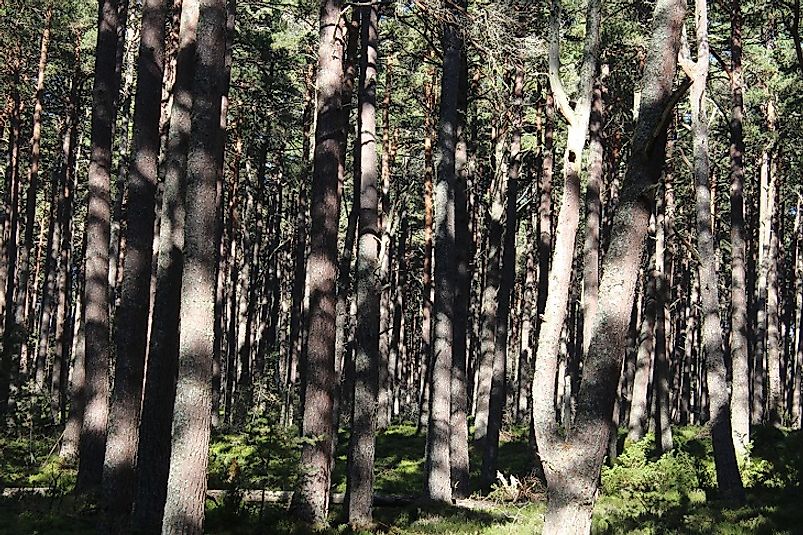What Was The Caledonian Forest?

5. Description
The temperate rainforests that once covered much of Scotland are referred to as the Caledonian Forest. The forest takes its name from the Romans who referred to Scotland as ‘Caledonia’, meaning 'wooded heights' in Latin. The dominant species of the Caledonian Forest, the Scot pines, are direct descendants of the first pines that arrived in Scotland way back in 7,000 BC. The forest probably reached its maximum range by about 5,000 BC, and thereafter climate change and human interventions gradually led to reductions of the forest's area. Today, the Caledonian Forest exists as 35 remnants, collectively covering an area of 180 square kilometers.
4. Historical Role
Forests like the Caledonian Forests once covered large tracts of land on the islands of Great Britain. However, as climate became warmer in the Atlantic Period, the temperate coniferous forests started retreating, becoming largely confined to the Scottish Highlands. Human activities in the region further shrunk the forest, resulting in its present forlorn state. Large volumes of timber and fuel were obtained by felling the forest trees, and these supported human life in the region for centuries. The Caledonian Forest often finds mention in ancient legends and folklore. The forest is assumed to be the site of King Arthur’s famous Twelve Battles, as per Historia Brittonum. The forest has been also mentioned as the retreat of such ancient Scottish and Gaelic folklore characters as Myrddin Wyllt and Lailoken.
3. Modern Significance
Much of today’s Caledonian Forest system is made up of ‘geriatric forests’ of old trees reaching the ends of their respective lifespans, with a newer trees attempting to replace the older ones, though doing so at a slower rate. Thus, as the old trees die, the forest will continue to shrink and there is a possibility that the forests will completely disappear within a few decades, if harmful human activities that are still wreaking havoc on the remnant forests are not checked and resolved. With the prospective death of the Caledonian Forests in their entirety, a number of rare and unique species will likely disappear from the region. The endemic species of the ecosystem, like the Scottish crossbill, for instance, could become completely extinct. The lure of the rare and strange varieties of birds and mammals inhabiting the Caledonian Forests also attract a large volume of tourists into the region. With the disappearance of the forests, tourist footfall into the region will also decline, causing the local economies to suffer. Thus, the Caledonian Forests hold immense significance in terms of maintaining Scotland’s biodiversity and tourism economy, and hence its preservation is of prime importance to the people of this region.
2. Habitat
The Caledonian Forest is a unique ecosystem of the British Isles, and is home to some of the rarest wildlife of the United Kingdom. Scots pines, alders, ash trees, aspens, hazels, holly trees, and oaks are but some of the plant species common to this area. The region is also a birdwatcher’s paradise, as it hosts a large number of breeding bird species that are either found nowhere else in the British Isles, or are otherwise rarely found elsewhere. These include the Crested tit, the Parrot crossbill, the Scottish crossbill, the Common golden-eye, the Black grouse, the Long-eared owl, the Goosander, the Wood sandpiper, and many others. Mammal species found in the region include feral goats, red deer, red foxes, roe deer, wildcats, and pine martens. A large number of mammalian species, like the Eurasian lynx, the brown bear, wild boar, elk, and a few others that once inhabited the Caledonian Forests have now gone extinct.
1. Threats and Disputes
The ancient Caledonian Forests have long faced the threat of extinction due to exploitative human activities in the region, which has led to the reduction of the forest to 5% of its original land area of 1.5 million hectares. According to reports, this forest is among the United Kingdom’s most endangered habitats. Deforestation to facilitate timber production and cattle grazing are the primary factors leading to the decline of these forests. Such deforesting activities have a long history, probably dating as far back as the Neolithic times. Trees were brought down to clear land for agriculture, and were used for fuel to heat and cook and timber to build. Some parts of the forest were also intentionally burnt to eliminate wolves and other wildlife, which were then largely regarded as ‘vermin’ endangering humans, crops, and livestock. As the population grew and industrialization began in the more recent years, trees were felled to satisfy the growing industrial fuel needs, as well as those of the railroad industry for cross-ties. The shrinking of the Caledonian Forests, however, continues to this date, attributed to human population pressures. Indirectly, this includes overgrazing by red deer. As a result of human’s interference with their food chain, an elimination of the predators of the red deer has caused their populations to grow, and they must source what is oft times scarce food resources from the fragile remnants of the Caledonian Forest.











